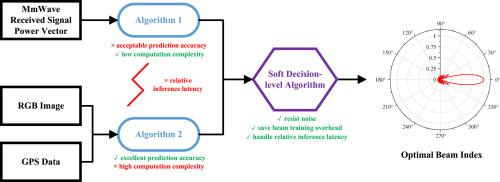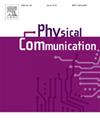Multi-modal fusion for sensing-aided beam tracking in mmWave communications
IF 2.2
4区 计算机科学
Q3 ENGINEERING, ELECTRICAL & ELECTRONIC
引用次数: 0
Abstract
Millimeter wave (mmWave) communication has attracted extensive attention and research due to its wide bandwidth and abundant spectrum resources. Effective and fast beam tracking is a critical challenge for the practical deployment of mmWave communications. Existing studies demonstrate the potential of sensing-aided beam tracking. However, most studies are focus on single-modal data assistance without considering multi-modal calibration or the impact of inference latency of different sub-modules. Thus, in this study, we design a decision-level multi-modal (mmWave received signal power vector, RGB image and GPS data) fusion for sensing-aided beam tracking (DMBT) method. The proposed DMBT method includes three designed mechanisms, namely normal prediction process, beam misalignment alert and beam tracking correction. The normal prediction process conducts partial beam training instead of exhaustive beam training, which largely reduces large beam training overhead. It also comprehensively selects prediction results from multi-modal data to enhance the DMBT method robustness to noise. The beam misalignment alert based on RGB image and GPS data detects whether there exists beam misalignment and also predict the optimal beam. The beam tracking correction is designed to capture the optimal beam if misalignment happens by reusing certain blocks in normal prediction process and possibly outdated prediction results. Finally, we evaluate the proposed DMBT method in the vehicle-to-infrastructure scenario based on a real-world dataset. The results show that the method is capable of self-correction and mitigating the negative effect of the relative inference latency. Moreover, 75%–93% beam training overhead can be saved to maintain reliable communication even when faced with considerable noise in measurement data.

毫米波通信中传感辅助波束跟踪的多模式融合
毫米波(mmWave)通信因其宽广的带宽和丰富的频谱资源而受到广泛关注和研究。有效而快速的波束跟踪是毫米波通信实际部署的关键挑战。现有研究证明了传感辅助波束跟踪的潜力。然而,大多数研究都侧重于单模式数据辅助,而没有考虑多模式校准或不同子模块的推理延迟的影响。因此,在本研究中,我们设计了一种决策级多模态(毫米波接收信号功率矢量、RGB 图像和 GPS 数据)融合传感辅助波束跟踪(DMBT)方法。所提出的 DMBT 方法包括三个设计机制,即正常预测过程、波束错位警报和波束跟踪校正。正常预测过程是进行部分波束训练,而不是详尽的波束训练,这在很大程度上减少了大量波束训练开销。它还从多模态数据中综合选择预测结果,以增强 DMBT 方法对噪声的鲁棒性。基于 RGB 图像和 GPS 数据的光束错位警报可检测是否存在光束错位,并预测最佳光束。波束跟踪校正的目的是在发生错位时,通过重复使用正常预测过程中的某些块和可能过时的预测结果来捕捉最佳波束。最后,我们基于真实世界的数据集,在车辆到基础设施的场景中对所提出的 DMBT 方法进行了评估。结果表明,该方法能够进行自我校正,减轻相对推理延迟的负面影响。此外,即使在测量数据存在大量噪声的情况下,也能节省 75%-93% 的波束训练开销,从而保持可靠的通信。
本文章由计算机程序翻译,如有差异,请以英文原文为准。
求助全文
约1分钟内获得全文
求助全文
来源期刊

Physical Communication
ENGINEERING, ELECTRICAL & ELECTRONICTELECO-TELECOMMUNICATIONS
CiteScore
5.00
自引率
9.10%
发文量
212
审稿时长
55 days
期刊介绍:
PHYCOM: Physical Communication is an international and archival journal providing complete coverage of all topics of interest to those involved in all aspects of physical layer communications. Theoretical research contributions presenting new techniques, concepts or analyses, applied contributions reporting on experiences and experiments, and tutorials are published.
Topics of interest include but are not limited to:
Physical layer issues of Wireless Local Area Networks, WiMAX, Wireless Mesh Networks, Sensor and Ad Hoc Networks, PCS Systems; Radio access protocols and algorithms for the physical layer; Spread Spectrum Communications; Channel Modeling; Detection and Estimation; Modulation and Coding; Multiplexing and Carrier Techniques; Broadband Wireless Communications; Wireless Personal Communications; Multi-user Detection; Signal Separation and Interference rejection: Multimedia Communications over Wireless; DSP Applications to Wireless Systems; Experimental and Prototype Results; Multiple Access Techniques; Space-time Processing; Synchronization Techniques; Error Control Techniques; Cryptography; Software Radios; Tracking; Resource Allocation and Inference Management; Multi-rate and Multi-carrier Communications; Cross layer Design and Optimization; Propagation and Channel Characterization; OFDM Systems; MIMO Systems; Ultra-Wideband Communications; Cognitive Radio System Architectures; Platforms and Hardware Implementations for the Support of Cognitive, Radio Systems; Cognitive Radio Resource Management and Dynamic Spectrum Sharing.
 求助内容:
求助内容: 应助结果提醒方式:
应助结果提醒方式:


